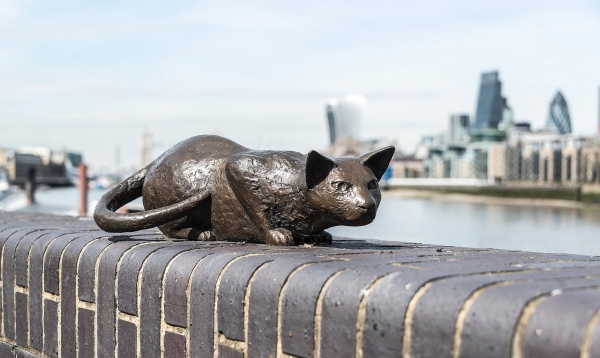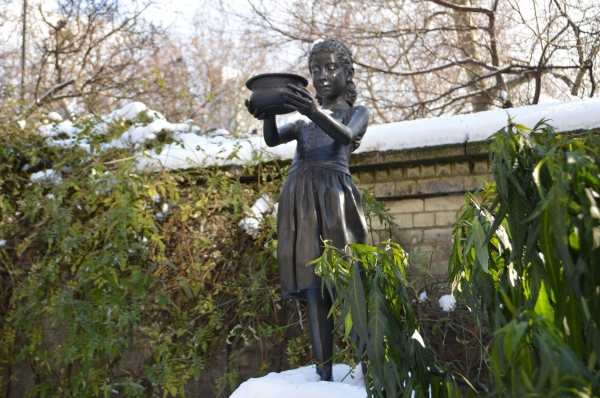We’ve come to the end of our Wednesday series on 10 (lesser known) memorials to women in London, so here’s the recap. We’ll kick off a new Wednesday series next week…
10 (lesser known) memorials to women
10 (lesser known) memorials to women in London – 10. Emmeline and Christabel Pankhurst…
And so we come to the last entry in our series on lesser known memorials to women in London. And for our final memorial, we’re heading to Westminster where a memorial actually commemorating two women – Suffragettes Emmeline Pankhurst (1858-1928) and her daughter Christabel (1880-1958) – sits in Victoria Tower Gardens next to the Houses of Parliament.
 Erected in 1930, the statue, which stands atop a central pedestal set in a low wall, was, according to the plaque on the front, installed as a tribute to Emmeline’s “courageous leadership of the movement for the enfranchisement of women” and was funded through subscriptions made to the Pankhurst Memorial Fund established following her death.
Erected in 1930, the statue, which stands atop a central pedestal set in a low wall, was, according to the plaque on the front, installed as a tribute to Emmeline’s “courageous leadership of the movement for the enfranchisement of women” and was funded through subscriptions made to the Pankhurst Memorial Fund established following her death.
Sculpted by Arthur George Walker (he also sculpted a statue of Florence Nightingale in Waterloo Place), the now Grade II-listed statue depicts Pankhurst standing with arms appealing to those before her as if addressing a crowd.
Inside the pedestal upon which the statue stands there is apparently a metal box containing some of her letters and an obituary to her published in The Times.
The statue, which was originally installed as a stand-alone monument further to the south of its current position (but still in the gardens), was unveiled on 6th March, 1930, by then Prime Minister Stanley Baldwin. The Metropolitan Police Band, conducted by Ethel Smyth, a friend of Pankhurst’s, played during the unveiling – some of those police officers who played had previously arrested Suffragettes.
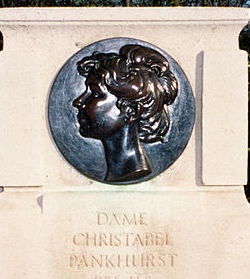 The monument was moved to its current location in 1958 and in 1959 the low wall was added to accommodate a second memorial, this one to Dame Christabel. It consists of two medallions sculpted by Peter Hill. Located at each end of the wall on either side of the statue, they depict the Women’s Social and Political Union badge, known as the “Holloway Prison brooch”, and a portrait of Christabel (right).
The monument was moved to its current location in 1958 and in 1959 the low wall was added to accommodate a second memorial, this one to Dame Christabel. It consists of two medallions sculpted by Peter Hill. Located at each end of the wall on either side of the statue, they depict the Women’s Social and Political Union badge, known as the “Holloway Prison brooch”, and a portrait of Christabel (right).
There are reportedly controversial plans to move the memorial to a site in The Regent’s Park. The proposed new site, which sits inside Regent’s University grounds, was apparently selected because of the historical association of the Suffragettes with Bedford College which once stood on the site.
There is also apparently a proposal for another statue of Emmeline Pankhurst to be located on Canning Green outside the Supreme Court on Parliament Square.
PICTURES: Top – Prioryman (licensed under CC BY-SA 4.0); Right – David Adams; Lower right – Lupo (licensed under CC BY 3.0/image cropped)
10 (lesser known) memorials to women in London – 9. Anna Pavlova…
This statue of famed ballerina Anna Pavlova (1881-1931) is actually a replica of an original which was first installed here atop the cupola of the Victorian Palace Theatre, in Victoria Street in the West End, in 1911.
Commissioned by the theatre’s owner, Alfred Butt, it had been installed to mark Pavlova’s London debut. The ballerina, who had started her career in Russia, moved to settle in Ivy House in Golders Green in 1912 and subsequently went on to tour the world.
It is believed that the gilded statue was the work of the theatre’s architect, Frank Matcham. Larger than life-sized (although that’s hard to ascertain given its lofty position), it depicts Pavlova in a classical tutu standing on one leg in what’s known as the “arabesque” position.
The story goes that the superstitious dancer hated the idea of the statue and always refused to look at it, even pulling closed the curtains on her cab when passing.
It was removed for safe-keeping in 1939 following the outbreak of World War II but apparently lost soon after.
The replica, which was created by Hary Franchetti based on photographs, was reinstalled in 2006. The fate of the original remains a mystery.
PICTURES: Top – amateur_photo_bore (licensed under CC BY-NC-ND 2.0); Below – David Adams.

10 (lesser known) memorials to women in London – 8. Virginia Woolf…
Located in Tavistock Square in Bloomsbury, this bronze bust of writer and literary pioneer Virginia Woolf (1882-1941) was erected in 2004.
 Commissioned by the Virginia Woolf Society of Great Britain, it is a copy of a bust of Woolf sculpted by Stephen Tomlin in 1931 (there is a 1953 version of the work, apparently the only 3D representation of Woolf taken from life, in the National Portrait Gallery) and was set on a Portland stone plinth designed by Stephen Barkway.
Commissioned by the Virginia Woolf Society of Great Britain, it is a copy of a bust of Woolf sculpted by Stephen Tomlin in 1931 (there is a 1953 version of the work, apparently the only 3D representation of Woolf taken from life, in the National Portrait Gallery) and was set on a Portland stone plinth designed by Stephen Barkway.
A plate on the plinth explains that Woolf, a central figure in the Bloomsbury group of writers and artists, lived from 1924 to 1939 in a house which once stood on the south side of Tavistock Square, the period when her greatest novels were written.
It also features a quote from Woolf concerning the writing of her novel To the Lighthouse – “Then one day walking round Tavistock Square I made up, as I sometimes make up my books, To the Lighthouse; in a great, apparently involuntary, rush.”
There are, incidentally, plans to erect a new life-sized, seated statue of Woolf at Richmond on the bank of the River Thames. Woolf and her husband Leonard lived for a time the riverside borough at Hogarth House (where they also ran their publishing company).
Mock-ups have been created by artist Laury Dizengremel and there is a funding appeal to raise £50,000 currently underway.
PICTURE: Maureen Barlin (licensed under CC BY-NC-ND 2.0)
10 (lesser known) memorials to women in London – 7. Catherine Booth…
Located at Denmark Hill in south London, this statue of Catherine Booth (1829-1890), co-founder of the Salvation Army, was apparently dedicated twice.
 The first dedication took place in 1929, the centenary of her birth, and the second the following year when an accompanying statue of her husband William Booth – they stand on either side of the entrance to the Salvation Army’s William Booth Memorial Training College, designed by Sir Giles Gilbert Scott (he also designed the statue plinths), on Champion Park – was also being dedicated.
The first dedication took place in 1929, the centenary of her birth, and the second the following year when an accompanying statue of her husband William Booth – they stand on either side of the entrance to the Salvation Army’s William Booth Memorial Training College, designed by Sir Giles Gilbert Scott (he also designed the statue plinths), on Champion Park – was also being dedicated.
The work of George Edward Wade, the bronze statue depicts Booth in her Salvation Army uniform – complete with bonnet – and has her holding a Bible pressed to her heart and reaching out with an open hand. Her husband William is also shown in his uniform, preaching from an open the Bible.
An inscription on the granite plinth below describes her “The Army Mother”. The larger than life statue was cast at the Morris Art Bronze Foundry.
There are, incidentally, exact replicas of both statues in Mile End Road in London’s east. Donated by the women of the Salvation Army in the US, that of William was unveiled in 1979 and that of Catherine a later addition, unveiled in 2015 on the 150th anniversary of the creation of the Salvation Army.
The statues are located close to the site where the Booths commenced the work of the Salvation Army in July, 1865.
PICTURE: R Sones (licensed under CC BY-SA 2.0/Image cropped)
10 (lesser known) memorials to women in London – 6. Sarah Siddons…
Located on Paddington Green, this statue of 18th century theatrical luminary Sarah Siddons (1755-1831) was unveiled by fellow thespian Sir Henry Irving on 14th June, 1897, who apparently noted that, Shakespeare aside, Siddons was the first actor to be immortalised with a statue in London.
 It is also said to be the first outdoor statue erected in London of a non-royal woman.
It is also said to be the first outdoor statue erected in London of a non-royal woman.
Seated in a pose apparently inspired by Joshua Reynolds’ 1784 painting, Mrs Siddons as the Tragic Muse (now in California), the marble statue, which sits on a Portland stone plinth, is the work of French sculptor Leon-Joseph Chavailliaud.
The location was apparently selected due to the fact Siddons lived at Westbourne Green from 1805 to 1817 and is buried in St Mary’s Churchyard next to Paddington Green.
The Grade II-listed statue, which was paid for by public subscription, is sadly now need of a makeover – Mrs Siddons is missing a nose.
There is, incidentally, another, earlier, statue of Mrs Siddons in London – this larger-than-life work, is located in the chapel of St Andrew in Westminster Abbey’s north transept.
The work of sculptor Thomas Campbell, it features a standing Mrs Siddons, and dates from 1845.
PICTURE: Stephencdickson (licensed under CC BY-SA 4.0)
10 (lesser known) memorials to women in London – 5. Ada Salter…
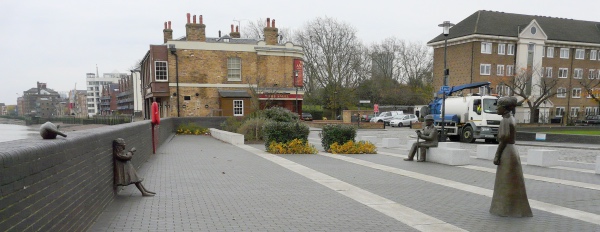
Since 1991, a statue of Dr Alfred Salter (as well as his daughter Joyce and cat) had sat on the south bank of the River Thames in Bermondsey.
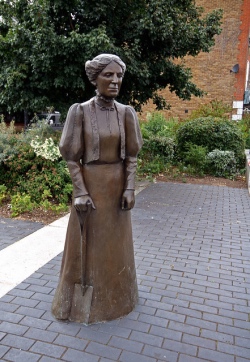 But after the statue of Dr Salter – MP for Bermondsey for many years – was stolen in 2011 (presumably for scrap value) and the statues of Joyce and the cat subsequently put into storage, it was decided to reassemble the group but this time adding in a new figure – that of Dr Salter’s wife Ada, whose story was certainly as significant as his.
But after the statue of Dr Salter – MP for Bermondsey for many years – was stolen in 2011 (presumably for scrap value) and the statues of Joyce and the cat subsequently put into storage, it was decided to reassemble the group but this time adding in a new figure – that of Dr Salter’s wife Ada, whose story was certainly as significant as his.
A social reformer, environmentalist and pacifist, Ada Salter (1866-1942) was co-founder and president of the Women’s Labour League, one of the first women councillors in London (she was elected to Bermondsey in 1909) and, on being appointed Mayor of Bermondsey in 1922, the first woman mayor in London and the first Labour woman mayor in Britain.
In 1931, she was elected chair of the National Gardens Guild. Together the couple, who were both Quakers, dedicated much of their lives to helping the people of Bermondsey, regenerating slums, building model housing and planting thousands of trees.
A campaign was subsequently launched to raise funds to replace the statue of Dr Salter and install a new one of Ada and, on raising £120,000 (the £60,000 raised was matched by Southwark Council), artist Diane Gorvin, who had designed the original statue of Dr Salter, was commissioned to make them.
The resultant statues – known collectively as ‘The Salter Statues’ and ‘Dr Salter’s Daydream’ – were unveiled where the previous grouping had been found at Bermondsey Wall East near the Angel pub, in November, 2014.
While Dr Salter sits on a granite bench looking toward the river and his daughter Joyce, who leans against the river wall watched by the family cat, Ada stands nearby – also looking at her daughter – but with a spade in her hand.
Writes the artist: “The idea was to show Dr Salter in old age remembering his young daughter when she was still alive. Ada is represented with a spade as she was so instrumental in tree and planting schemes for Bermondsey. Her left hand is designed to hold real flowers. It was important to celebrate the work of this couple who dedicated their lives to helping the local community.”
There’s a poignant aspect to the statues in that Joyce, the couple’s only child, had died at the age of eight from scarlet fever in 1910.
Ada Salter also has a garden named after her in Southwark Park.
PICTURE: Top – Loz Pycock (licensed under CC BY-SA 2.0 – image cropped and lightened); Right – Marc Pether-Longman (licensed under CC-BY-NC-ND-2.0); Below – Steve James (licensed under CC-BY-NC-ND 2.0).
10 (lesser known) memorials to women in London – 4. Noor Inayat Khan…
 Located in Gordon Square Gardens in King’s Cross, this bust commemorates British agent Noor Inayat Khan (1914-1944), who was executed during World War II.
Located in Gordon Square Gardens in King’s Cross, this bust commemorates British agent Noor Inayat Khan (1914-1944), who was executed during World War II.
Khan, who was of Indian descent (in fact, a direct descendent of Tipu Sultan of Mysore), had escaped to England from her home in Paris after the fall of France during World War II. She joined the Women’s Auxiliary Air Force (WAAF) in November, 1940, and in 1942 was recruited to join the Special Operations Executive (SOE) as a radio operator.
In June, 1943, she became the first female radio operator to be flown into occupied France. There she worked for the “Prosper” resistance network under the code name Madeleine but in October she was betrayed and arrested by the Gestapo.
Sent to Germany the following month, she was held in prison before, in September 1944, Khan and three other female SOE agents were transferred to Dachau concentration camp where they were shot on the 13th of that month. Her last word was said to have been “Liberte”.
Khan, dubbed the “Spy Princess” by her biographer, was posthumously awarded the George Cross and the French Croix de Guerre.
The bust of her in Gordon Square Gardens was unveiled by Princess Anne, the Princess Royal, on 8th November, 2012. A message from her brother Hidayat Inayat-Khan was read out at the unveiling.
The bust is believed to be the first stand-alone memorial to an Asian woman in the UK. The work of Karen Newman, it was commissioned by the Noor Inayat Khan Memorial Trust.
Various inscriptions on the bust plinth provide biographical details and also record that Noor lived nearby and “spent some quite time in this garden”.
PICTURE: Matt Brown (licensed under CC BY 2.0)
10 (lesser known) memorials to women in London – 3. Lady Henry Somerset…
A bird bath and drinking fountain located in Victoria Embankment Gardens, this monument dedicated to Lady Henry Somerset – a key temperance campaigner – was unveiled in the late 19th century.
 Lady (Isabella) Somerset (1851-1921) was president of the British Women’s Temperance Association from 1890 to 1903, president of World’s Women’s Christian Temperance Union between 1989 and 1906, and founder of a farm colony for inebriate women near Reigate in Surrey.
Lady (Isabella) Somerset (1851-1921) was president of the British Women’s Temperance Association from 1890 to 1903, president of World’s Women’s Christian Temperance Union between 1989 and 1906, and founder of a farm colony for inebriate women near Reigate in Surrey.
The monument isn’t actually a true memorial – Lady Somerset was still alive when the bronze, sculpted by GE Wade was unveiled on 29th May, 1897. It had been commissioned by the “Children of The Loyal Temperance Legion” to commemorate Lady Somerset’s “work done for the temperance cause”.
The monument – which depicts a young girl holding out a basin – was Grade II-listed in 1958.
The original statue, however, was stolen in 1971 after it was sawn off at the feet. The statue which now stands there is actually a replica – by Philomena Davidson Davis – installed in 1999.
As well as the dedication, the rough granite plinth upon which the statue stands bears the rather odd inscription (given Lady Somerset’s campaigning), “I was thirsty and ye gave me drink.”
PICTURE: Top – Matt Brown (licensed under CC BY 2.0); Right – Another Believer (licensed under CC BY-SA 4.0)
10 (lesser known) memorials to women in London – 2. Margaret Ethel MacDonald…
Located on the north side of Lincoln’s Inn Fields, this rather elaborate monument commemorates Margaret Ethel MacDonald (1870-1911), wife of the first British Labour Prime Minister Ramsay MacDonald, a noted feminist and social activist.
The Grade II-listed monument, which was unveiled in December, 1914 – three years after her death (which occurred before her husband became PM), stands not far from the flat where she lived with her husband and their children at Number 3.
It features a granite seat atop which is a bronze group of sculptures of nine children gathered around the kneeling MacDonald – the work of Richard Goulden. At the top of the seat – just below the sculptures, is a dedication to MacDonald “who spent her life in helping others”.
On the rear is a plaque containing biographical details and further dedication ending with the words that she “took no rest from doing good”.
PICTURE: mapa mundi (licensed under CC BY-SA 2.0)
10 (lesser known) memorials to women in London – 1. Dame Louisa Brandreth Aldrich-Blake…

We’re kicking off a new Wednesday series this week and in honour of the fact that a statue of Millicent Fawcett became the first commemorating a female to be erected in Parliament Square earlier this year, we’re looking at 10 other memorials – lesser known ones – to women in London.
 First up, it’s a Grade II-listed monument in Tavistock Square Gardens commemorating Louisa Brandreth Aldrich-Blake (1865-1925), the first female surgeon in Britain and pioneer of new surgical methods treating cancers of the cervix and rectum. She was also dean of the London School Of Medicine For Women.
First up, it’s a Grade II-listed monument in Tavistock Square Gardens commemorating Louisa Brandreth Aldrich-Blake (1865-1925), the first female surgeon in Britain and pioneer of new surgical methods treating cancers of the cervix and rectum. She was also dean of the London School Of Medicine For Women.
This double-sided monument, which sits above a curved seat, features two busts of Dame Aldrich-Blake, both holding a book. On the sides of the monument are the depictions of the Rod of Asclepius – an intertwined staff and serpent long used as a symbol for the medical profession.
The base and seat were designed by Edwin Lutyens – the man behind the Cenotaph – and the identical bronze busts were the work of Arthur George Walker.
The monument was apparently erected in 1926, a year after Dame Aldrich-Blake’s death, in a rather fitting location, Tavistock Square is the location of the headquarters of the British Medical Association in BMA House.
As well as listing her achievements in the world of medicine, the monument bears the rather uplifting inscription: “The path of the just is as the shining light”.
PICTURE: Top – Stu’s Images (licensed under CC BY-SA 3.0); Right – Robin Sones (licensed under CC BY-SA 2.0)


